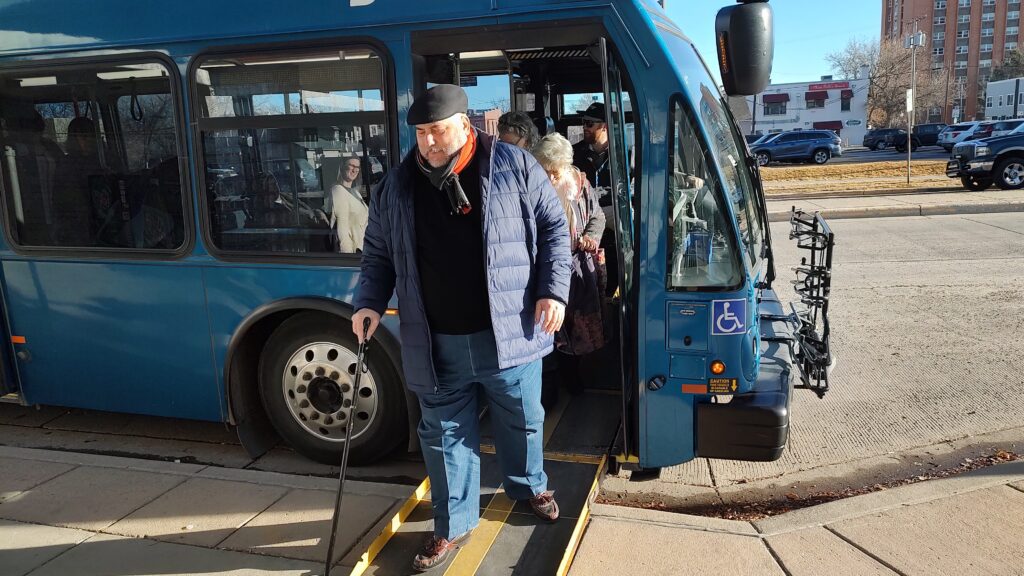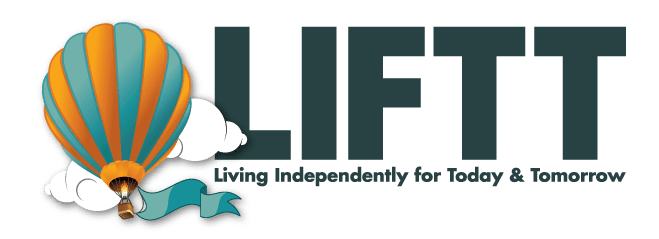
LIFTT Director Carlos Ramalho steps off a Billings MET Transit Bus. Inclusion through Transportation is the theme of this year’s LIFTT ADA Anniversary Celebration, which will be held from 11 to 3 on Friday, July 26.
Equal access to public and private transportation systems for older adults and people with disabilities is vital for enabling these groups to participate fully in society, accessing employment, education, healthcare, and social activities. It is in recognition of this vitality that LIFTT has chosen “Aging and Disability Inclusion through Transportation” as the theme for our celebration of the 34th anniversary of the Americans with Disabilities Act on July 26.
What does an accessible transportation system look like? As the center for independent living (CIL) for Southeast and South-Central Montana, how does LIFTT contribute to making inclusive transportation a reality? What are the advantages of including people with disabilities and older adults in the transportation system? I hope you will read on as this article explores these questions and perhaps feel compelled to share your own thoughts and ideas with us here at LIFTT. I also hope to see all of you at the ADA celebration on Friday July 26, from 11 a.m. to 3 p.m. at our Billings office (1241 Crawford Drive).
What does an accessible transportation system look like?
Physical Accessibility
- Transportation Facilities Locations such as bus stops, train stations and airports, must be designed to accommodate older adults and people with disabilities. This includes features like ramps, elevators, wide doorways, and tactile paving.
- Planes, Trains & Automobiles Whatever the mode of transportation, vehicles should be equipped with low floors, ramps, wheelchair spaces, and appropriate seating to ensure ease of use for everyone.
Information Accessibility
-
Real-Time Information Providing accessible information about schedules, routes, and delays through multiple formats is crucial. Audio announcements, visual displays, and digital applications help ensure that everyone can access the information they need.
- Wayfinding Clear and accessible signage, braille, and audio guidance systems help individuals navigate transportation systems more effectively. This is particularly important for those with visual or cognitive impairments.
Accessibility of Services and Policies
- Training for Staff Transportation staff should be educated in how to assist older adults and individuals with disabilities effectively and respectfully. Training programs can help staff understand the specific needs of these groups and how best to support them.
- Policies Implementing policies that prioritize and protect the rights of older adults and individuals with disabilities ensure they are not discriminated against and receive the necessary support. This includes ensuring compliance with regulations and promoting inclusive practices.
- Stakeholder Engagement in Policymaking Involving older adults and people with disabilities in the planning and decision-making processes for transportation projects ensures their needs are considered. This collaborative approach leads to more effective and inclusive solutions.
- Accessible Technology and Innovation Incorporating technologies such as mobile apps for ride-sharing services that are accessible to older adults and people with various disabilities can greatly enhance mobility options. Additionally, research and development into autonomous vehicles and the use of wheelchairs aboard airliners can provide new opportunities for independent travel.
How does LIFTT contributes to making the inclusion of the aging and disabled in Transportation a reality?
- Advocacy and Awareness LIFTT can advocate for the rights of older adults and people with disabilities by engaging with policymakers and transportation authorities to ensure inclusive practices are implemented. Raising awareness about the importance of accessible transportation is a key part of this advocacy. LIFTT can also support people with disabilities and older adults as they engage in self-advocacy for their transportation needs.
- Community Engagement By involving older adults and individuals with disabilities in discussions and feedback sessions regarding transportation needs and improvements, LIFTT ensures their voices are heard and their needs are met.
- Education and Training LIFTT can provide training programs for transportation staff to ensure they understand and can effectively support the needs of aging individuals and those with disabilities. This training can improve the overall quality of service.
- Support Services LIFTT can assist with navigating transportation options, including providing resources and guidance on accessible routes and services. This support can make a significant difference in the daily lives of those who rely on transportation services.
- Technology Integration By collaborating with tech developers, LIFTT can help create and promote the use of accessible transportation technologies, ensuring they meet the needs of the community. This integration can lead to more innovative and effective solutions.
- Partnerships Partnering with transportation providers, LIFTT can help design and implement accessible transportation solutions tailored to the needs of older adults and people with disabilities. These partnerships can enhance the overall accessibility of transportation systems.
What are the benefits of Aging and Disability Inclusion in Transportation?
- Enhanced Mobility Inclusion efforts lead to greater independence and ease of movement for older adults and individuals with disabilities, allowing them to navigate their communities more freely.
- Social Integration Increased opportunities for social interaction and community participation result from accessible transportation options. This integration helps reduce isolation and promotes a sense of belonging.
- Economic Participation Better access to employment opportunities and economic activities is a key benefit of inclusive transportation. It enables individuals to contribute to and benefit from the economy.
- Improved Quality of Life Overall, the quality of life is enhanced by reducing isolation and increasing access to essential services. Inclusive transportation ensures that everyone has the opportunity to participate fully in society.
Aging and disability inclusion through transportation is a multifaceted approach that requires collaboration between government agencies, transportation providers, community organizations, and the individuals directly affected. LIFTT’s is committed to being involved in these process so that we can join in significantly enhance the effectiveness of these efforts and ensure that transportation systems are truly inclusive and accessible for everyone. If you have a transportation accessibility issue or would like to join others in advocating for inclusive transportation options, please give us a call at (406) 259-5181 or visit our website at liftt.org
See you at the ADA celebration on July 26!
Carlos Ramalho, Executive Director
July 2024
